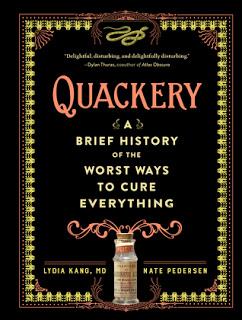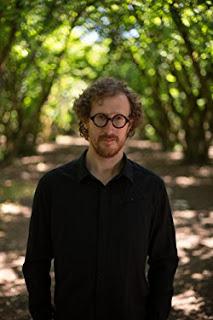
ABOUT THE BOOK:
Discover 67 shocking-but-true medical misfires that run the gamut from bizarre to deadly. Like when doctors prescribed morphine for crying infants. When snorting skull moss was a cure for a bloody nose. When consuming mail-order tapeworms was a latter-day fad diet. Or when snake oil salesmen peddled strychnine (used in rat poison) as an aphrodisiac in the '60s. Seamlessly combining macabre humor with hard science and compelling storytelling, Quackery is a visually rich and information-packed exploration of history's most outlandish cures, experiments, and scams.
A humorous book that delves into some of the wacky but true ways that humans have looked to cure their ills. Leeches, mercury, strychnine, and lobotomies are a few of the topics that explore what lengths society has gone in the search for health.
READ AN EXCERPT:
MY REVIEW:
 Quackery: A Brief History of the Worst Ways to Cure Everything by Lydia Kang
Quackery: A Brief History of the Worst Ways to Cure Everything by Lydia KangMy rating: 4 of 5 stars
Quackery: A Brief History of the Worst Ways to Cure Everything by Lydia King is a 2017 Workman Publishing Company publication.
A jaw dropping collection of gruesome and ghastly concoctions and procedures guaranteed to cure whatever ails you… if it doesn’t kill you first.
Before there was an FDA to weed out potentially dangerous ‘snake oil cures', the market was open to all manner of experimental potions and concoctions sold to an unsuspecting public.
This is a fascinating look at some of the most horrifying cases where strychnine and arsenic found its way into tonics designed to cure specific ailments or used for beauty treatments.
As the title suggests this is a very brief history of incredible cure-alls, medical treatments and procedures- It is not a comprehensive tome, full of dry material. Instead, it hits upon the most outrageous instances in history and as such, it makes for an informative and interesting read and is a book that you may want to keep around for reference.
It is unbelievable and shocking at times, and could make some readers a little uncomfortable. While some of these methods may have been well intentioned, none of these so -called cures were proven, studied, analyzed or deemed safe for human use, especially in such large doses or frequency.
But, even when proof surfaced of the danger some of these chemicals posed, cover-ups were not unheard of- such as with the tobacco industry, which cleverly employed doctors to advertise their products.
The chapter on tobacco was particularly interesting on several levels, as was the chapter on cocaine.
But, the second half of the book was dedicated to procedures such as performing a lobotomy, bloodletting, leeches, and the tools! - Which was akin to using torture devices.
Thank goodness, the author chose to use humor as a way of off- setting the more cringe worthy areas of the book.
In fact, I found myself chuckling a few times at the author's dry wit and jokes, which took gallows humor to a whole new level. But, maybe I just have a warped sense of humor.
Even though we do have agencies that test products for long term side effects and safety, and one could go on a long diatribe about the frustrations the FDA can cause when erring on the side of caution, slowing down the process for potentially life- saving drugs, or, on occasion they miss potential dangers, or allow carefully worded descriptions on food labels that are very misleading, there are still many products lining shelves today that promise quick weight loss, miracle cures, and don’t even get me started on the claims many beauty aids try to sell you. Although they are normally safe to use, they hardly produce the dramatic results as advertised.
When you see a disclaimer on a bottle of vitamins declaring it is not backed by the FDA, you may want to do a little research. Many of these over the counter pills, herbs, and tonics could interact with medication, or they just don’t work- period. I’ve used these natural herbs, many times, with various degrees of success, but I do urge caution.
My point, is that charlatans, swindlers and con artists are still as plentiful as they were back centuries ago, often catering to and taking advantage of people who are desperate, looking for a quick beauty or weight loss fix. So, despite our many advances some things never change.
However, I for one, am glad it is a bit harder to poison people with Arsenic, Antimony, or Strychnine. I am also happy we know the dangers of tobacco use and that cocaine is addictive, and surgeons wash their hands and wear surgical gloves, and that their tools are sanitized- so there is that.
Overall, this is a fascinating look back at practices, rituals, and chemicals we once thought were okay to use, but as it turns out- not so much. It also makes me appreciate how far we’ve come medicinally, and thankful we don’t use bugs, snakes, or animals based medicine- (or use them for testing), or depend upon the touch of a King to cure us.
This is a quick read, replete with photographs and drawings, and sketches. This book will appeal to history buffs, science and medicine enthusiasts, or anyone who likes to read educational material, or trivia.
The book is well organized and utterly fascinating!
GET YOUR COPY HERE:
https://www.amazon.com/Quackery-Brief-History-Worst-Everything-ebook/dp/B06XDX2X15/ref
https://www.barnesandnoble.com/w/quackery-lydia-kang-md/1125369976
ABOUT THE AUTHORS:

Lydia Kang is an author and internal medicine physician. She is a graduate of Columbia University and New York University School of Medicine, and completed her training at Bellevue Hospital in New York City. She lives with her family in the midwest. Follow her on Twitter @LydiaYKang and Instagram @LydiaKang.

Nate is a Community Librarian with Deschutes Public Library and serves on the Board of Directors for the Deschutes County Historical Society & Museum. He is a member-at-large, representing Central Oregon, on the Oregon Heritage Trees Commission. He also lectures frequently on historical topics around the state.
Nate’s journalism has appeared in The Art of Manliness, The Guardian, Trail Runner and The Believer. He is a blogger with Fine Books & Collections. His scholarly publications have appeared in the Oregon Historical Quarterly and the Oregon Encyclopedia.
He lives in Bend, Oregon with his wife and two dogs, enjoying spending as much time as possible in the mountains and desert.

